

The outer Galilean moons also consist of exterior ice (probably commingled with some rock), atop an interior containing a rocky core and perhaps overlying liquid water or slush. Some scientists have speculated on the presence of a sub-ice ocean beneath Ganymede's icy crust that might harbor organic molecules and even simple life forms. We can show the surfaces of these satellites best in medium-contrast, black and white images. Ganymede, the third moon from Jupiter, at 1,070,000 km (664,898 mi), is the largest (diameter = 5,263 km [3,270 mi]) satellite in the solar system (larger than the planet Mercury). Galileo effectively imaged Ganymede, as shown in this scene:
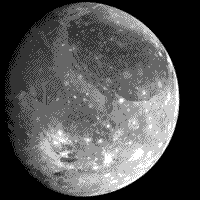
The full view highlights the two dominant terrains, seen better in this close-up:
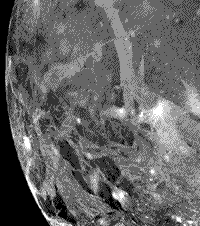
We judge both terrains as old (ancient) based on crater densities. The dark terrain occurs in patches, some with straight sharp boundaries, abruptly against the other type¾ lighter-toned terrain with ridges and grooves. The darker terrain appears older and may have been part of a crust that after breaking apart was invaded and at times surrounded by the younger material. Each terrain seems to consist of ice, with the dark areas possibly foundering in later-mobilized water-ice. Tectonic plates presumably stressed the grooved terrain to produce parallel ridges (terrestrial sea ice can develop similar but less pronounced structures). Further breakups cause smaller polygons to wedge in a sometimes jumbled patchwork.
19-59:
Below, we compare a high-resolution, Galileo image (right) of grooved terrain with a Voyager 2 image of the same area (left), proving dramatically the value of improved viewing capabilities that inevitably ensue as sensors get better and spacecraft pass closer to their targets.
The difference resulting from 75 m (246 ft) resolution (right) versus approximately 1.3 km (4264 ft) for the left image is obvious. We again depict this type of terrain, in which grooved surfaces make up a patchwork of juxtaposed individual segments, each in sharp contrast to its neighbors, in the next sequence of three images, the last taken in July of 1998, during Galileo's last, and closest, approach:
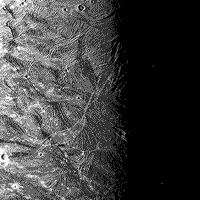

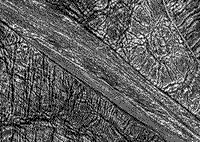
The craters on Ganymede, as well
as those on Callisto, the last of the Galilean four, differ from those on,
say, the Moon, in that nearly all of them lack raised rims and central peaks.
For larger craters this should be conspicuous, but the effects of gravity
almost completely obliterate these impact effects by causing these features
to collapse or slump down as the ice responds by viscous flow that levels
the higher sections of the structures. A notable exception are the pair of
craters shown in an image collected during the July, 1998, close approach.
These craters show broad raised rims(the forms resemble splash boundaries
of short-lived craters produced by an object thrust into water), and dark
floors, which may be material carried up from bedrock below any ocean water
beneath the ice.
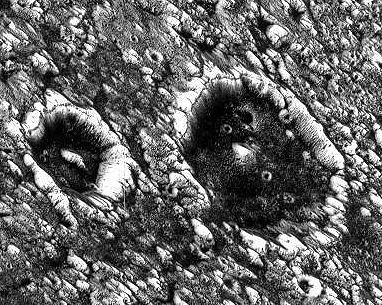
Occasionally, there are strings of close-spaced craters in a long row, as
seen in the lower scene.
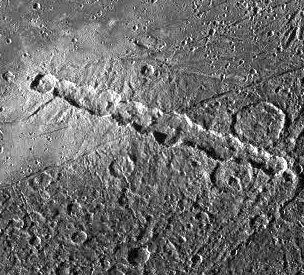
Note the details in the left view below. Occasionally, there are strings of close-spaced craters in a long row, as seen in the right scene.
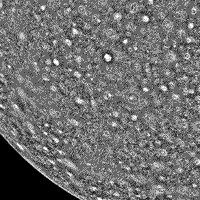

Such an arrangement is likely due to the breakup of an incoming bolide or projectile that bombarded the surface in a succession of pieces, perhaps similar to the now famous 1994 sequence of collisions on Jupiter's surface by strung-out fragments of the Comet Shoemaker-Levy, about which we will comment near the end of this section.
Parts of Ganymede's surface have jumbled icy blocks that look like small mountains; thus:
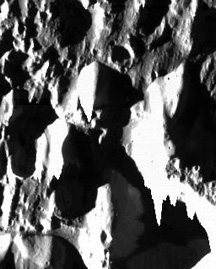
19-60:
The Near Infrared Mapping Spectrometer on Galileo is capable of producing maps like the one below of Ganymede that show the broad distribution of ice (green or blue) versus what may be a mix of ice and rock (black or red).
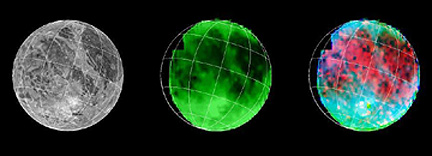
Callisto (4800 km [2981 miles] diameter; 1,883,000 km [1,169, 343 miles] from Jupiter's center) is dominated by a single terrain made up of darker materials (possibly like the dark terrain of Ganymede). Seen in full as a photomosaic made from nine Voyager 1 images, this satellite appears to be pockmarked by thousands of lighter spots, which are impact scars in the icy surface:
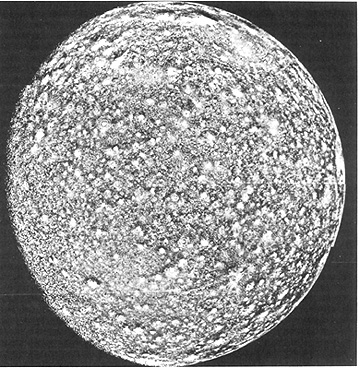
Note the details in the view below.
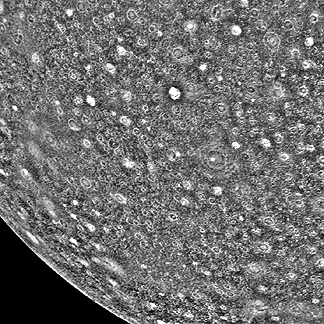
19-61:
Seen close-up by Galileo, this is a typical impact crater on Callisto. Note the jumbled nature of the rim.
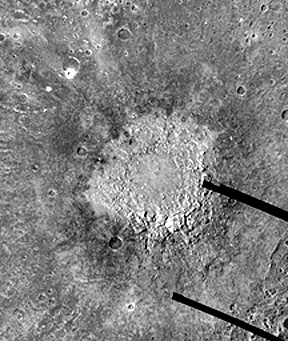
Our last look at Callisto shows the great series of concentric ice rings at Valhalla Basin:
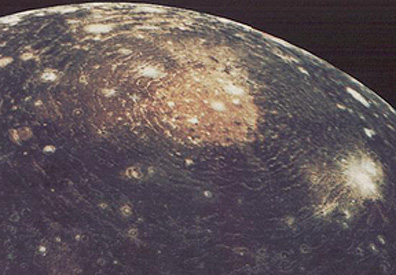
This multiringed structure has counterparts in the Caloris Basin of Mercury and Mare Orientale on the Moon. The rings formed during or shortly after a collision that scooped out the central basin. They are crudely analogous to multiple rings in water caused by a stone. The rings in ice tended to stay "frozen" in place as they formed. Over time, these topographic rims, and those of larger craters, tended to diminish in height due to the flow of ice outward from the rise.
19-62:
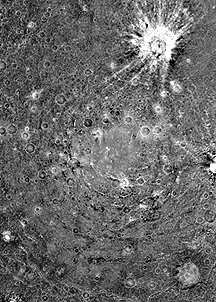
Even as this section was undergoing review and revision, JPL scientists have announced that the Galileo probe detected organic molecules on Ganymede and Callisto. Details as to types or species are not available.
Jupiter has 16 satellites all told (several discovered by Voyager and Galileo). Typical of the smaller satellites is Amalthea (150 x 270 km [93 x 167 miles], whose irregular shape and reddish color (sulphur coating?} is shown here:
Amalthea is the largest of the four inner small satellites (in orbits between Jupiter and Io):

From left to right (with lengths as shown): Melis (60 km; 37 miles); Adrastea (20 km; 12 miles) (discovered by the Galileo spacecraft); Amalthea (247 km; 154 miles); Thebes (116 km; 72 miles). Of the 8 beyond the orbit of Callisto, Elara is the largest (80 km; 50 miles); they occur in four pairs.
Quoting from a December 1997 JPL Press release:
The key findings of Galileo's primary mission include:
The discovery of volcanic ice flows and melting or "rafting" of ice on the surface that support the presence of liquid oceans underneath at some point in Europa's history.
The observation of water vapor, lightning, and aurora on Jupiter.
The discovery of an atmosphere of hydrogen and carbon dioxide on the moon, Callisto.
The presence of metallic cores in Io, Europa, and Ganymede (but not Callisto).
Evidence of very hot volcanic activity on Io and observations of dramatic changes compared to previous observations.

Primary Author: Nicholas M.
Short, Sr. email: nmshort@epix.net
Contributor Information
Last Updated: September '99
Site Curator: Nannette Fekete